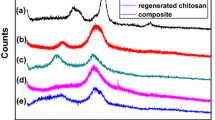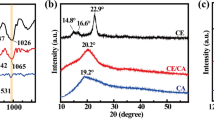Abstract
A series of Cellulose/poly-ethylene imine (PEI) composites were prepared by grafting hyperbranched PEI onto cellulose chains in alkali/urea aqueous solvent system through “one step” method. The SEM results showed that the Cellulose/PEI composite maintained porous structure. The Cellulose/PEI composites were tested as Cu(II) adsorbents through thermodynamics and kinetics study. The adsorption process followed pseudo-second-order kinetics equation. The adsorption isotherms could be described by both Langmuir and Freundlich isotherm models. The maximum adsorption amount was calculated to be 285.7 mg/g. The composites showed good stability so that they could be used in a wide range of pH and temperature. Besides, the Cu(II) loaded Cellulose/PEI composite could also be easily regenerated by dilute sulfuric acid and still keep a major adsorption capacity. Finally, the adsorption capacities of Celluloes/PEI composite towards other metal ions, such as Zn(II), Ni(II), Cr(III) and Pb(II), were also demonstrated. It will be a new high-performance and environmental friendly material for sewage disposal and metal pollution treatment with promising developmental potential.









Similar content being viewed by others
References
Adhikari BB, Gurung M, Alam S, Tolnai B, Lnoue K (2013) Kraft mill lignin-a potential source of bio-adsorbents for gold recovery from acidic chloride solution. Chem Eng J 231:190–197. doi:10.1016/j.cej.2013.07.016
Annadurai G, Juang RS, Lee DJ (2002) Use of cellulose-based wastes for adsorption of dyes from aqueous solutions. J Hazard Mater 92:263–274. doi:10.1016/S0304-3894(02)00017-1
Babel S, Kurniawan TA (2003) Low-cost adsorbents for heavy metals uptake from contaminated water: a review. J Hazard Mater 97:219–243. doi:10.1016/S0304-3894(02)00263-7
Bao Y, Yan X, Du W, Xie X, Pan Z, Zhou J, Li L (2015) Application of amine-functionalized mcm-41 modified ultrafiltration membrane to remove chromium (VI) and copper (II). Chem Eng J 281:460–467. doi:10.1016/j.cej.2015.06.094
Cai J, Zhang L, Liu S, Liu Y, Xu X, Chen X, Chu B, Guo X, Xu J, Cheng H, Han C, Kuga S (2008) Dynamic self-assembly induced rapid dissolution of cellulose at low temperatures. Macromolecules 41:9345–9351. doi:10.1021/ma801110g
Chang C, Zhang L, Zhou J, Zhang L, Kennedy JF (2010) Structure and properties of hydrogels prepared from cellulose in NaOH/urea aqueous solutions. Carbohyd Polym 82:122–127. doi:10.1016/j.carbpol.2010.04.033
Dai J, Yan H, Yang H, Cheng R (2010) Simple method for preparation of chitosan/poly(acrylic acid) blending hydrogel beads and adsorption of copper(ii) from aqueous solutions. Chem Eng J 165:240–249. doi:10.1016/j.cej.2010.09.024
Demirbas E, Dizge N, Sulak MT, Kobya M (2009) Adsorption kinetics and equilibrium of copper from aqueous solutions using hazelnut shell activated carbon. Chem Eng J 148:480–487. doi:10.1016/j.cej.2008.09.027
Diwakar T, Seung M (2011) Biomass-derived materials in the remediation of heavy-metal contaminated water: removal of cadmium(II) and copper(II) from aqueous solutions. Water Environ Res 83:874–881. doi:10.2175/106143011X12928814445258
Dwivedi AD, Dubey SP, Hokkanen S, Fallah RN, Sillanpää M (2014) Recovery of gold from aqueous solutions by taurine modified cellulose: an adsorptive-reduction pathway. Chem Eng J 255:97–106. doi:10.1016/j.cej.2014.06.017
Feng N, Guo X, Sha L (2009) Adsorption study of copper (II) by chemically modified orange peel. J Hazard Mater 164:1286–1292. doi:10.1016/j.jhazmat.2008.09.096
He Z, Song H, Cui Y, Zhu W, Du K, Yao S (2014) Porous spherical cellulose carrier modified with polyethyleneimine and its adsorption for Cr(III) and Fe(III) from aqueous solutions. Chin J Chem Eng 22:984–990. doi:10.1016/j.cjche.2014.07.001
Ho YS, McKay G (1999) Pseudo-second order model for sorption processes. Process Biochemistry 34:451–465. doi:10.1016/S0032-9592(98)00112-5
Katsutoshi I, Kazuharu Y, Keisuke O (1999) Adsorptive separation of some metal ions by complexing agent types of chemically modified chitosan. Anal Chim Acta 388:209–218. doi:10.1016/S0003-2670(99)00090-2
Liu R, Tang C, Zhao J, Liu H (2014) Electrospun membranes of nanoporous structure cellulose acetate and its adsorptive behaviors using copper(II) as models. Desalin Water Treat 56:1768–1775. doi:10.1080/19443994.2014.958108
Liu Y, Xu X, Wang M, Lu T, Sun Z, Pan L (2015) Metal-organic framework-derived porous carbon polyhedra for highly efficient capacitive deionization. Chem Commun (Camb) 51:12020–12023. doi:10.1039/c5cc03999a
Melone L, Bonafede S, Tushi D, Punta C, Cametti M (2015a) Dip in colorimetric fluoride sensing by a chemically engineered polymeric cellulose/bPEI conjugate in the solid state. Rsc Advances 5:83197–83205. doi:10.1039/c5ra16764g
Melone L, Rossi B, Pastori N, Panzeri W, Mele A, Punta C (2015b) Tempo-oxidized cellulose cross-linked with branched polyethyleneimine: nanostructured adsorbent sponges for water remediation. ChemPlusChem 80:1408–1415. doi:10.1002/cplu.201500145
Messori L, Casini A, Gabbiani C, Sorace L, Muniz-Miranda M, Zatta P (2007) Unravelling the chemical nature of copper cuprizone. Dalton T 21:2112–2114. doi:10.1039/b701896g
Mohammed N, Grishkewich N, Berry RM, Tam KC (2015) Cellulose nanocrystal-alginate hydrogel beads as novel adsorbents for organic dyes in aqueous solutions. Cellulose 22:3725–3738. doi:10.1007/s10570-015-0747-3
Ngah WSW, Hanafiah MAKM (2008) Removal of heavy metal ions from wastewater by chemically modified plant wastes as adsorbents: a review. Bioresour Technol 99:3935–3948. doi:10.1016/j.biortech.2007.06.011
O’Connell DW, Birkinshaw C, O Dwyer TF (2008) Heavy metal adsorbents prepared from the modification of cellulose: a review. BioresourTechnol 99:6709–6724. doi:10.1016/j.biortech.2008.01.036
Oshima T, Taguchi S, Ohe K, Baba Y (2011) Phosphorylated bacterial cellulose for adsorption of proteins. Carbohyd Polym 83:953–958. doi:10.1016/j.carbpol.2010.09.005
Peng S, Meng H, Ouyang Y, Chang J (2014) Nanoporous magnetic cellulose–chitosan composite microspheres: preparation, characterization, and application for Cu(II) adsorption. Ind Eng Chem Res 53:2106–2113. doi:10.1021/ie402855t
Peterson RE, Bollier ME (1955) Spectrophotometric determination of serum copper with biscyclohexanoneoxalyldihydrazone. Anal Chem 27:1195–1197
Qiao H, Zhou Y, Yu F, Wang E, Min Y, Huang Q, Pang L, Ma T (2015) Effective removal of cationic dyes using carboxylate-functionalized cellulose nanocrystals. Chemosphere 141:297–303. doi:10.1016/j.chemosphere.2015.07.078
Qiu B, Guo J, Zhang X, Sun D, Gu H, Wang Q, Wang H, Wang X, Zhang X, Weeks BL, Guo Z, Wei S (2014) Polyethylenimine facilitated ethyl cellulose for hexavalent chromium removal with a wide pH range. ACS Appl Mater Inter 6:19816–19824. doi:10.1021/am505170j
Repo E, Warchol JK, Kurniawan TA, Sillanpää MET (2010) Adsorption of Co(II) and Ni(II) by EDTA- and/or DPTA-modified chitosan: kinetic and equilibrium modeling. Chem Eng J 161:73–82. doi:10.1016/j.cej.2010.04.030
Sehaqui H, Larraya UPD, Liu P, Pfenninger N, Mathew AP, Zimmermann T, Tingaut P (2014) Enhancing adsorption of heavy metal ions onto biobased nanofibers from waste pulp residues for application in wastewater treatment. Cellulose 21:2831–2844. doi:10.1007/s10570-014-0310-7
Setyono D, Valiyaveettil S (2015) Functionalized paper-a readily accessible adsorbent for removal of dissolved heavy metal salts and nanoparticles from water. J Hazard Mater. doi:10.1016/j.jhazmat.2015.09.046
Srivastava VC, Swamy MM, Mall ID, Prasad B, Mishra IM (2006) Adsorptive removal of phenol by bagasse fly ash and activated carbon: equilibrium, kinetics and thermodynamics. Colloids Surf A 272:89–104. doi:10.1016/j.colsurfa.2005.07.016
Sun X, Yang L, Xing H, Zhao J, Li X, Huang Y, Liu H (2013) Synthesis of polyethylenimine-functionalized poly(glycidyl methacrylate) magnetic microspheres and their excellent Cr(VI) ion removal properties. Chem Eng J 234:338–345. doi:10.1016/j.cej.2013.08.082
Tang Y, Ma Q, Luo Y, Zhai L, Che Y, Meng F (2012) Improved synthesis of a branched poly(ethylene imine)-modified cellulose-based adsorbent for removal and recovery of Cu(II) from aqueous solution. J Appl Polym Sci 4:1799–1805. doi:10.1002/APP.38878
Wang Q, Zhang D, Tian S, Ning P (2014) Simultaneous adsorptive removal of methylene blue and copper ions from aqueous solution by ferrocene-modified cation exchange resin. J Appl Polym Sci 21:41021–41029. doi:10.1002/APP.41029
Wang J, Lu X, Ng PF, Lee KI, Fei B, Xin JH, Wu J (2015) Polyethylenimine coated bacterial cellulose nanofiber membrane and application as adsorbent and catalyst. J Colloid Interface Sci 440:32–38. doi:10.1016/j.jcis.2014.10.035
Wu R, Tian L, Wang W (2015) Synthesis of a nanocomposite of organo-montmorillonite/cellulose-g-poly(methyl methacrylate) by atom-transfer radical polymerization and its application in removal of 2,4-dichlorophenol. Cellulose 22:3633–3643. doi:10.1007/s10570-015-0751-7
Xiong X, Duan J, Zou W, He X, Zheng W (2010) A pH-sensitive regenerated cellulose membrane. J Membr Sci 363:96–102. doi:10.1016/j.memsci.2010.07.031
Yan H, Yang L, Yang Z, Yang H, Li A, Cheng R (2012) Preparation of chitosan/poly(acrylic acid) magnetic composite microspheres and applications in the removal of copper(II) ions from aqueous solutions. J Hazard Mater 229–230:371–380. doi:10.1016/j.jhazmat.2012.06.014
Zatta P, Raso M, Zambenedetti P, Wittkowski W, Messori L, Piccioli F, Mauri PL, Beltramini M (2005) Copper and zinc dismetabolism in the mouse brain upon chronic cuprizone treatment. Cellular & Molecular Life Sciences Cmls 62:1502–1513. doi:10.1007/s00018-005-5073-8
Zhao L, Mitomo H (2008) Adsorption of heavy metal ions from aqueous solution onto chitosan entrapped CM-cellulose hydrogels synthesized by irradiation. J Appl Polym Sci 110:1388–1395. doi:10.1002/app.28718
Zhou L, Wang Y, Liu Z, Huang Q (2009) Characteristics of equilibrium, kinetics studies for adsorption of Hg(II), Cu(II), and Ni(II) ions by thiourea-modified magnetic chitosan microspheres. J Hazard Mater 161:995–1002. doi:10.1016/j.jhazmat.2008.04.078
Acknowledgments
This work is sponsored by the National Natural Science Foundation of China (51273067, 21544003).
Author information
Authors and Affiliations
Corresponding author
Rights and permissions
About this article
Cite this article
Ge, H., Huang, H., Xu, M. et al. Cellulose/poly(ethylene imine) composites as efficient and reusable adsorbents for heavy metal ions. Cellulose 23, 2527–2537 (2016). https://doi.org/10.1007/s10570-016-0973-3
Received:
Accepted:
Published:
Issue Date:
DOI: https://doi.org/10.1007/s10570-016-0973-3




